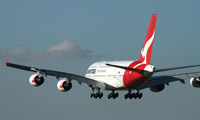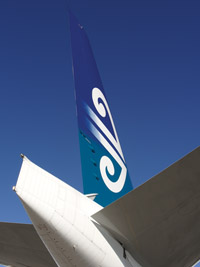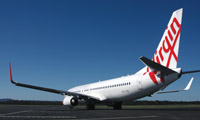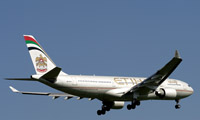Main Story
IS THE ALLIANCE 'CLUB' LOSING ITS CLOUT?
The recent emergence of new style airline partnerships has again raised questions about the future of the industry’s recognized global alliances, Star, oneworld and SkyTeam. Is their use-by date approaching as their alliance members increasingly seek bilateral co-operation outside “the club”?
April 1st 2013
There is hardly a better example of the divergent views splitting industry and analysts about the value of global airline alliances than the new partnership being forged between Dubai-based Emirates Airline and Australia’s Qantas Airways. Read More »
 |
| Tim Clark, Chief Executive, Emirates Airline: will not join an alliance and has suggested their behaviour is akin to global “gang warfare” |
Launched as an alliance that will change the industry, it highlights the “smoke and mirrors” aspect of airline relationships.
Outspoken Emirates chief executive, Tim Clark, doesn’t like alliances and has suggested their behaviour is akin to global “gang warfare”.
He says they create a “join or perish” commercial incentive for non-aligned airlines. Emirates, he declared, has no intention of joining an alliance.
On the other hand, the chief executive of a oneworld founding member, Alan Joyce, believes alliances have never been more important.
“Partnerships between airlines increase choice and deliver benefits for customers in a way that no one carrier can achieve on its own. They are essential if airlines are to remain competitive in today’s dynamic and volatile global economy,” he said.
Clearly, Clark’s antipathy doesn’t bother Joyce when it comes to what might be the greater good for Qantas inside or outside oneworld.
And in linking hands across the Indian Ocean with Dubai, moving the Kangaroo Route axis point between Australia and the UK from Singapore to the Middle East, Joyce had no qualms about ending the long-time joint service agreement with oneworld partner, British Airways (BA).
In February, BA told Qantas it would not be renewing its code-share with the carrier from Asia to London. It’s a sign of the times.
 |
| Qantas Airways: a founding member of oneworld, it has formed a landmark alliance with unaligned Emirates Airline and has a code-share with SkyTeam’s China Eastern with which it is also hoping to launch LCC, Jetstar Hong Kong |
While alliance membership continues to increase, individual members are showing their pragmatic face as they forge bilateral agreements with non-member airlines and even members of opposing alliances.
It is a trend that is becoming more prevalent as airlines strive to engineer stable profitability in a difficult global economic climate. Deeper bilateral ties and virtual alliances between smaller groups of airlines, some already in major alliances, are emerging.
In a February report, Macquarie Equities Research analysts, Russell Shaw and David McGregor, highlighted the significant strategic changes that have taken place in global aviation. They said the most pertinent trend was traditional global alliances now playing second fiddle to strong bilateral agreements.
The analysts suggested traditional global alliances were being undermined. Middle Eastern carriers were forging closer ties with their former competitors and an increasing number of bilateral alliances and partnerships were being formed that have started to transcend the traditional global alliances.
“A case in point is Air New Zealand [Star Alliance] forming an alliance with Cathay Pacific [oneworld] on flights between New Zealand and Hong Kong, as well as into certain points in Asia,” said the report.
“Going forward we believe trans-alliance partnerships are likely to become more prevalent as end-of-line carriers, in particular, revisit their international networks. They will become alliance-indifferent when considering the best way to improve returns on what are traditionally the least profitable parts of their business.”
Yet in the face of this, the three major alliances continue to represent a powerful bloc. Their combined 58 members operate more than 9,900 aircraft, hold a 77.1% share of the global passenger market and turn over annual revenue of $391.83 billion, 86% of world airline income.
Alliances themselves agree they are at a turning point and must adapt to changing circumstances.
 |
| 'With 27 members … we’re not rushing off to add lots of new members to simply get bigger' |
| Mark Schwab Chief Executive Star Alliance |
But oneworld chief executive, Bruce Ashby, said that doesn’t mean they are reaching their sell-by date. “Why have alliances proved so successful? It is because they provide benefits to their member airlines and their customers,” he said.
“They expand the reach of airlines’ networks and brands and deliver cost efficiencies. For customers, they provide more convenience, services, rewards and recognition. In an industry of thin profit margins these benefits are enormously attractive.”
The chief executive of one Star Alliance member told Orient Aviation privately that there has been serious discussion within the group about the future direction of the alliance and the need for it to adapt to changing times.
Star is the largest of the alliances with 27 members. Said chief executive, Mark Schwab: “What does Star do next? It will continue to strengthen the proposition that we offer to our customers, but we realize that with the many carriers we have in the network we need to remain very focused on delivering the details of the proposition.
“So we have a very robust business plan to make sure we are completely delivering. We have a lot of projects going on.”
SkyTeam, which has gained strength in the Asia-Pacific, particularly in China, also has no doubts about the future. Its managing director, Michael Wisbrun, said the industry was facing tumultuous times. “As an alliance we can and must add value to our members’ businesses. We do that by focusing on three priority areas; enriching our customer proposition, looking for new opportunities to expand and strengthen our global network and finding synergies for our members.”
The future of alliances has been raised before, but the question has re-emerged in recent times because of a number of separate developments.
Airline consolidation has had an impact, particularly in the U.S. While some involved carriers within alliances, such as Delta Air Lines with Northwest Airlines (both in SkyTeam) and United-Continental (both in Star), the merger of American with U.S. Airways will see the latter leave Star and join oneworld.
The UK’s bmi, also a Star member, crossed to oneworld when it was acquired by IAG, the parent company of BA and Iberia. When it merged with China Eastern, Shanghai Airlines left Star and joined SkyTeam.
 |
| Star Alliance carrier Air New Zealand formed a code-share agreement with oneworld member Cathay Pacific Airways |
But members have been moving to strengthen their extra alliance relationships, like Qantas’ deal with Emirates. Qantas also has a strong code-share with SkyTeam’s China Eastern and has entered into a joint venture agreement with the carrier to establish budget operator, Jetstar Hong Kong.
“Virtual alliances” are popping up too, including the innovative equity partnerships Abu Dhabi’s Etihad Airways is building, creating its own personal airline grouping.
It has taken stakes in non-alliance carriers Virgin Australia, Aer Lingus and Air Seychelles and oneworld member, airberlin. Virgin has created its own virtual alliance without equity stakes. Its partners are Star members Singapore Airlines, Delta and Air New Zealand (Air NZ), together with non-alliance carrier Etihad.
“They are not global alliances per se, but they are trying to sort out, bilaterally, gaps in their networks,” said Star chief Schwab. “For many years, the Gulf carriers said ‘we can do it by ourselves’ with slightly different opinions from one to the other, but generally they were going to grow organically.
“What has become clear to everybody is that they need partnerships. They need to find a way to tap into whole markets that they don’t have on their own. So we’re beginning to see this trend towards bilateral partnerships.”
Ashby said oneworld offered a clear proposition. Passengers knew what they were receiving. “You get rewards, you get recognition, you use the lounge, the world is open to you when you are away from your home airline,” he said.
“This is hard to replicate with patchwork bilateral alliances. The airlines with those bilaterals can’t say that. What they can say is ‘we have a lot of deals one by one with other airlines. There’s one type of benefit here and another type of benefit there and trust us, it will all work out’.”
Etihad chief executive, James Hogan, would not agree. He says Etihad’s partner airlines work to offer high standards of service across the board and that there are frequent flyer links and lounge access between carriers.
Indeed, Etihad recently acquired 70% of airberlin’s top bonus frequent flyer scheme and is in the process of working towards it managing all the partner airlines schemes. Etihad and its partners are also reaping bottom line gains from such things as joint pilot and cabin crew training facilities, maintenance and aircraft utilization.
 |
 |
| Virgin Australia and Etihad Airways: both are spearheading “virtual” alliances made up of alliance and non-alliance members |
Ashby said oneworld had a basic customer proposition that had a lot of value. It was easy to explain and people liked it, he said.
“That’s not to say people don’t get value from external relationships. They do. oneworld doesn’t go everywhere and all our members have external relationships that fill gaps in their network,” he said.
“What’s different about oneworld is that we encourage it. We don’t require our members to ask permission to do things that are good for their business. This is in contrast to the other alliances, which have pretty strict rules.”
Qantas’ Joyce echoed that sentiment. “Qantas has always understood the power of alliances, which is why we became a founding member of oneworld in 1999. The aviation world has changed since then, but alliances have become even more important.
“We have seen the rise of commercial joint ventures which bond carriers more closely together than a simple code-share. As Qantas’ network has grown and evolved we have extended our links with our oneworld partners.”
At the same time, he explained, Qantas has established close partnerships with airlines outside oneworld. “That is the nature of aviation in the 21st Century. We are seeing the emergence of a sophisticated, multi-layered global alliance network and that’s fantastic for international travellers.”
Star has been seen as an alliance which has stricter rules about its members working with non-members. But nothing is set in stone.
The Air NZ deal with Cathay is an example and the reason was simple. Air NZ needed a code-share on routes to and through Hong Kong and Star had no member there.
Schwab said Star was engaged in putting together a foundation for global connectivity. “But then within Star we strongly encourage deepening bilateral relationships. So typically you see a carrier join Star, as Asiana did 10 years ago, and they begin strengthening their relationships with other members of the alliance,” he said.
“They believe that they are joining a family of like-minded carriers and their tendency is to strengthen their relationships with specific members.”
Star admits it has “gaps”. “I would say that with 27 members Star is a comprehensive global network, so we’re not rushing off to add lots of new members to simply get bigger,” said Schwab.
“We’ve been very strategic about trying to fill a few gaps in the global network that still exist for us. India remains a bit of the gap in the network, so we’re looking to find the right solution for Star in India.
“In the longer term, we continue to view Russia as an opportunity for us. When TAM eventually leaves our alliance we will have a gap. We are working towards a solution for Brazil to plug that particular gap.”
In a development that would have been unimaginable just a few years ago, airlines from Taiwan and mainland China earlier this year signed a deal to work together on flights across the Taiwan Strait.
Essentially an alliance within an alliance, Taiwan’s China Airlines and Mainland carriers China Southern Airlines, China Eastern Airlines and Xiamen Airlines are all Skyteam members. They have joined forces in an effort to capture a greater share of the lucrative cross-strait market between mainland China, Hong Kong and Taiwan.
Tagged the “Greater China Connection”, it extends across more than 41 airports and includes more than 270 weekly flights, about half of the total capacity between mainland China and Taiwan.
The alliance will develop new products and marketing strategies for cross-strait traffic, as well as expanding frequent flyer membership privileges.
Consultant, CAPA, said the alliance is indicative of the growing trend for North Asian airlines to combine their strengths against imposing competitors, namely Air China and Cathay Pacific.
Everyone agrees that whatever the future of alliances, the Gulf will play an important role in that future. Last year brought major developments from the region’s airlines with Etihad’s ongoing equity investments, Emirates linking with Qantas and Qatar announcing it would join oneworld. Qatar surprised everyone because until then the Gulf operators had eschewed alliance membership.
Macquarie Equities researchers Shaw and McGregor said 2012 was the year in which the airline industry changed its views on the Middle Eastern hub carriers. It departed from the long-held view of seeing the rising airlines as threats and moving towards embracing them as fully fledged strategic partners.
“The most obvious example of this is the Qantas-Emirates deal, although Etihad has struck a similar deal with Air France-KLM. British Airways is looking to sponsor Qatar Airways into the oneworld alliance,” said the analysts in their report.
“We see these changes in the legacy carrier perspectives as fairly seismic, given, in many respects, the shift in attitude can be viewed as an admission the Middle Eastern carriers are here to stay. In the future more and more flying, under bilateral alliances, is likely to be on the Middle Eastern carriers’ metal, given their lower unit costs and potentially lower cost of capital.”
One major issue that continues to trouble global alliances is their inability to bring their members significant savings through joint purchase of major assets. For example, while they have achieved big savings in areas such as IT systems, spare parts, sharing of lounges and marketing, they have been unable to make major joint purchases of jets because individual members simply won’t accept a “generic” aircraft.
They want their own individual interior designs and layout. Similarly, with fuel. While there has been some joint purchasing of aviation kerosene it hasn’t been enough to offset high fuel prices for airlines.
Star’s chief operating officer and general counsel, Jeffrey Goh, said Star has been running joint sourcing ventures for many years and that fuel procurement is saving members $20 million to $30 million on average per year. But that remains a very small percentage of total fuel purchases.
A new Star Alliance economy seat has been jointly developed and will be fitted in about 60 aircraft this year. Considering the alliance has more than 2,600 planes this again represents small beginnings.
As far as LCCs and their growing global strength in markets around the world, alliances appear to have no fears.
“Our alliance is focused on the high value international traveller,” said Schwab. “We provide the ability to fly to more than 1,300 destinations globally, our customers can take advantage of joint FFP opportunities, lounge access and many other service benefits.
“LCCs may have some negative impact on Star members on a local basis, but no LCC is going to pose any significant threat to our global proposition.”
Some analysts have suggested time may be running out for alliances because of the growing number of airline approvals for anti-trust immunity (ATIs) and the gradual relaxation of restrictions on airline mergers.
“In reality, that’s just not credible,” said Ashby. “Within oneworld, airline cooperation has been enhanced by ATIs and solidified by mergers. Both have helped to maximize benefits to customers and carriers.
“But the 50-plus airlines now in alliances are not about to merge suddenly into three global mega-carriers or plunge into a vast web of ATIs with dozens of others simply because they belong to the same alliance.”
He said the trend towards mergers and ATIs means the continued growth and development of alliances is becoming more complex.
“To add to the complexity, many airlines — aligned and unaligned — have deep bilateral ties with, and sometimes investments in, carriers across multiple alliances,” said Ashby.
“Also, many unaligned airlines have no plans to conform to the full-service model maintained by the members of the three alliances. Alliances need to find effective new models of cooperation if they are to remain relevant to their members. Creative solutions to problems are needed; accepted wisdom often cannot be applied.
“For example, it used to be thought that only full service airlines would join alliances. Yet in March 2012, oneworld added airberlin, which only a few years ago was considered a pure low-cost carrier.
“Of course, the business model of airberlin has evolved since then, as it added product enhancements to attract more customers and become Europe’s sixth biggest airline. These enhancements have made airberlin capable of delivering all of oneworld’s offerings.”
Looking ahead, he said the evolution of today’s low-cost and hybrid carriers coupled with some creative re-thinking of alliance participation requirements will provide a rich field for continued membership growth, extending alliance benefits to new customers.
“Meanwhile, as long as there are mergers and acquisitions, alliances will have to cope gracefully with sudden shifts in membership,” added Ashby.
Alliances: their strengths and weaknesses
 |
| Garuda Indonesia: will become the seventh Skyteam member in the Asia-Pacific in 2014 |
In the Asia-Pacific, there is no doubt that SkyTeam, the last of the big three alliances to be formed in 2000, has been able to forge the strongest network.
In Mainland China it has two of that country’s top three carriers, China Eastern and China Southern Airlines, as members, as well as Xiamen Airlines, which joined last year.
Elsewhere in the region it has Taiwan’s China Airlines, Korean Air and Vietnam Airlines, with Garuda Indonesia to join in 2014. It has major carrier, Air France, in Europe and another major, Delta Air Lines in the U.S. In the Middle East, Saudi Airlines is a Skyteam member.
In terms of numbers, oneworld is the smallest group, but its membership is seen as high quality, with major carriers such as American Airlines in the U.S., British Airways in Europe and Qantas Airways, Japan Airlines, Cathay Pacific Airways and Malaysia Airlines in the Asia-Pacific.
It lacks a Chinese member and relies on Cathay to fill that role. It has only one member in the Middle East, Royal Jordanian, but Qatar Airways is set to join. Last month, in the fast growing South American region, the merged LATAM (LAN of Chile and TAM of Brazil) opted to go with oneworld. LAN was already a member of the alliance.
Star Alliance, with 27 members, has good coverage in the Asia-Pacific. Its members include Air China and Shenzen Airlines in China, as well as major operators, Singapore Airlines, All Nippon Airways, Asiana Airlines and Thai Airways International, with Taiwan’s EVA Air lined up to join.
In Africa, Star has Egyptair and Ethiopian Airlines, but lacks a major Middle East member. In North America, United Airlines is a member (US Airways will be included as it merges with United) and Air Canada.
In South America, it has Avianca and TACA, but is losing TAM Airlines to oneworld.
None of the alliances have a member in the major growth area of India.
| SkyTeam | Star Alliance | oneworld | ||
| Members: 19 Aeroflot, Aerolineas Argentina, AeroMexico, Air Europa, Air France, Alitalia, China Airlines, China Eastern Airlines, China Southern Airlines, Czech Airlines, Delta Airlines, Kenya Airways, KLM, Korean Air, MEA (Middle East Airlines), Saudi Airlines, Tarom, Vietnam Airlines, Xiamen Airlines Founded: 2000 Destinations: 1,000 Countries served: 187 Daily departures: approximately 15,465 Annual passengers: 552 million Lounges: 525 Fleet: 2,734 mainline fleet (+1,403 from related carriers) Employees: 436,007 Annual revenue: $97.9 billion Market share: 24.6% |
Members: 27 Adria Airways, Aegean Airlines, Air Canada, Air China, Air New Zealand, All Nippon Airways, Asiana Airlines, Austrian Airlines, Avianca, TACA Airlines, Brussels Airlines, Copa Airlines, Croatia Airlines, Egyptair, Ethiopian Airlines, LOT Polish Airlines, Lufthansa German Airlines, Scandinavian Airlines, Shenzhen Airlines, Singapore Airlines, South African Airways, SWISS, TAM Airlines (will leave next year to join oneworld), TAP Portugal, Turkish Airlines, Thai Airways International, United Airlines (with US Airways). EVA Air has been announced as a future member. Founded: 1997 Destinations: 1,329 Countries served: 194 Daily departures: 21,900 Annual passengers: 670.58 million Lounges: over 1,000 Fleet: 4,570 Employees: 448,926 Annual revenue: $181.83 billion Market share: 29.3% |
Members: 12 airberlin, American Airlines, British Airways, Iberia, Cathay Pacific Airways, Finnair, Japan Airlines, LAN, Malaysia Airlines, Qantas Airways, Royal Jordanian, S7 Airlines. Sri Lankan Airlines and Qatar Airways are future members. Founded: 1999 Destinations: 859 Countries served: 156 Daily departures: 9,228 Annual passengers: 360.1 million Lounges: 584 Fleet: 2,605 Employees: 296,317 Annual revenue: $112.1 billion Market share: 23.2% |